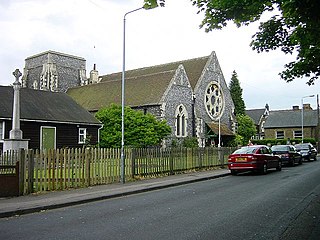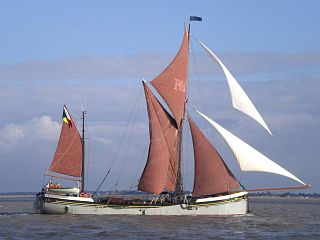Related Research Articles

The Croydon Canal ran 9+1⁄4 miles (15 km) from Croydon, via Forest Hill, to the Grand Surrey Canal at New Cross in south London, England. It opened in 1809 and closed in 1836, the first canal to be abandoned by an act of Parliament.

Sittingbourne is an industrial town in the Swale district of Kent, southeast England, 17 miles (27 km) from Canterbury and 45 miles (72 km) from London, beside the Roman Watling Street, an ancient trackway used by the Romans and the Anglo-Saxons.

A Thames sailing barge is a type of commercial sailing boat once common on the River Thames in London. The flat-bottomed barges, with a shallow draught and leeboards, were perfectly adapted to the Thames Estuary, with its shallow waters and narrow tributary rivers. The larger barges were seaworthy vessels, and were the largest sailing vessel to be handled by just two men. The average size was about 120 tons and they carried 4,200 square feet (390 m2) of canvas sail in six working sails. The mainsail was loose-footed and set up with a sprit, and was brailed to the mast when not needed. It is sheeted to a horse, as is the foresail; they require no attention when tacking. The foresail is often held back by the mate to help the vessel come about more swiftly.

London stock brick is the type of handmade brick which was used for the majority of building work in London and South East England until the increase in the use of Flettons and other machine-made bricks in the early 20th century. Its distinctive yellow colour is due to the addition of chalk. Another important admixture is 'spanish', which is made up of ash and cinders from incinerated waste and rubbish. The spanish ignites on firing and reduces fuel costs at the firing stage.
James Parker was English businessman, clergyman, and inventor who invented one of the pioneering new cements of the late eighteenth century.
Priday, Metford and Company Limited was a family-run company that produced flour at the City Flour Mills, Gloucester, England for over a century. They were closed down in 1994 and the premises were converted to luxury apartments under the name of "Priday's Mill". The City Flour Mills was the location of the landmark case in contract law known as Hadley v. Baxendale.

Frindsbury is part of the Medway Towns conurbation in Kent, southern England. It lies on the opposite side of the River Medway to Rochester, and at various times in its history has been considered fully or partially part of the City of Rochester. Frindsbury today is part of the town of Strood and covers the most northern part of the town. Frindsbury refers to both a parish and a manor. Within the civil parish of Frindsbury Extra are the villages of Frindsbury, Wainscott, and Upnor. Frindsbury was also the name given to an electoral ward in the City of Rochester that straddled the parishes of Frindsbury and Strood.

Murston is a suburb of Sittingbourne, in the Swale district, in the county of Kent, England. It is about 1 mile north-east of central Sittingbourne, on the east bank of the Milton Creek.

Conyer is a hamlet within Teynham civil parish in the borough of Swale in Kent, England. It is located around one mile north of the village of Teynham, and at the head of Conyer Creek, which flows into the Swale to the north. The Saxon Shore Way and National Cycle Route 1 pass through the hamlet.
Frindsbury TQ744697 51°23′58″N0°30′29″E is a parish on the River Medway, on the opposite bank to Chatham Dockyard in Kent, England. It was a centre of ship building before 1820, building at least six 74 gun third rate ships of the line and many smaller vessels. From 1820, until recent times, the ship yards built over 100 Thames sailing barges. Shipbuilding has stopped but in 2006, one yard was still active in ship repair.

Lucky Cement Limited, also known as Lucky Group, is a Pakistani conglomerate headquartered in Karachi, Sindh. Named after the place, Lakki Marwat, where the first plant was commissioned in 1993, Lucky has become one of the largest cement producers in Pakistan. It has 15.3 million tonnes per annum of manufacturing capacity. The company is listed on the Pakistan Stock Exchange.

Thalatta is a Thames sailing barge, built in Harwich, Essex, in 1906 and rebuilt in St Osyth in 2012. She is 90 feet (27 m) long and 26 feet (7.9 m) across the widest part of the deck. Like all Thames barges, she is flat-bottomed and has leeboards instead of a keel. She spent some of her life ketch-rigged and some of it spritsail-rigged. She is now permanently spritsail rigged, and has a mainmast and topmast that, together, are about 90 feet (27 m) high, and a mizzen mast. Thalatta has had two periods with an auxiliary engine and two without. She carried cargo for sixty years and was then converted for use as a sail training ship in 1966. She was completely rebuilt between 2006 and 2012 at St Osyth with assistance from lottery funds.

A brickfield is a field or other open site where bricks are made. Land may be leased by an owner to a brickmaster, by whom the manufacture of bricks may be conducted. Historically, the topsoil was typically removed and the clay beneath was stripped and mixed with chalk and ash to make bricks.
In pre-19th-century England, [i]n most areas the brickfield owner hired a brickmaster at a price per thousand bricks to superintend the site and take full responsibility for the output of the operations. He in turn contracted with moulders to temper, mould and hack the bricks. Each moulder then hired his own 'gang' of subsidiary labourers and acted as their employer.

Will is a Thames sailing barge, built in Great Yarmouth by Fellows & Co in 1925. She is 97.6 ft (29.75 m) long, 23.1 ft (7.04 m) across and 9.6 ft (2.93 m) deep. Will Everard, as she was originally known, was commissioned as one of four steel barges; the largest ever built. She is a mulie, with a spritsail rigged mainmast, a topmast and a gaff-rigged mizzen. She has a flat bottom with leeboards as is customary for Thames sailing barges. As one of the last sailing cargo vessels to operate in UK waters she left trade in 1966. After a few years lying derelict, she was refitted and eventually entered into the service of P&O where she was used as a floating board room until 1999. This role in corporate hospitality continued and she now is fully engaged in private charter work. She currently operates out of the Pool of London from a base at Hermitage Community Moorings, Reeds Wharf and St Katherine Docks for cruises through London, the east coast and beyond.

Thos. W. Ward Ltd was a Sheffield, Yorkshire, steel, engineering and cement business, which began as coal and coke merchants. It expanded into recycling metal for Sheffield's steel industry, and then the supply and manufacture of machinery.

Cliffe is a village and former civil parish, now in the parish of Cliffe and Cliffe Woods, in the borough of Medway in the ceremonial county of Kent, England. It is on the Hoo Peninsula, reached from the Medway Towns by a three-mile (4.8 km) journey along the B2000 road. Situated upon a low chalk escarpment overlooking the Thames marshes, Cliffe offers views of Southend-on-Sea and London. In 774 Offa, King of Mercia, built a rustic wooden church dedicated to St Helen, a popular Mercian saint who was by legend the daughter of Coel of Colchester. Cliffe is cited in early records as having been called Clive and Cliffe-at-Hoo. In 1961 the parish had a population of 2239. On 1 April 1997 the parish was abolished to form "Cliffe & Cliffe Woods", part of which consisting of Frindsbury Extra.

SB Centaur is a wooden Thames sailing barge, built in Harwich, Essex, England in 1895. She was used to carry various cargoes, mainly grain, for the next 60 years. During the First World War she carried food and coal to the French Channel ports. During the Second World War Centaur was damaged when sailing to assist with the Dunkirk Evacuation. She did war work for the duration of the conflict.

SB Lady Daphne is a wooden Thames sailing barge, built in Rochester, England in 1923. She was used to carry various cargoes such as bricks and Portland stone on the River Thames and along the English Channel. She is infamous for sailing unaided from The Lizard to Tresco in the Scilly Isles, and safety beaching herself in two feet of water on shelving sand.

Ironsides is an iron-hulled Thames barge which was built in 1900 for APCM. She was registered in London. A 60 hp auxiliary engine was fitted in 1939.

George Smeed is a Thames barge built in 1882 by Smeed Dean & Co. Ltd. in Murston.
References
- ↑ "Cement Kilns: Teynham".
- ↑ "AUCLAYE BRICKFIELDS LIMITED - 00222720 incorporated 23/06/1927 - company credit reports and accounts - bizzy". Archived from the original on 24 April 2012. Retrieved 16 December 2011.
- ↑ "A. & W. T. RICHARDSON LIMITED - 00187002 incorporated 11/01/1923 - company credit reports and accounts - bizzy". Archived from the original on 24 April 2012. Retrieved 16 December 2011.
- ↑ "Mersea Museum - Thames Barge list". www.merseamuseum.org.uk. Retrieved 17 May 2018.